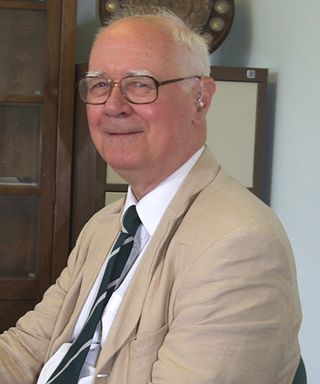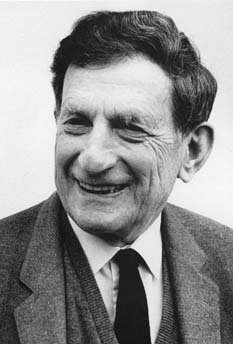
John Charlton Polkinghorne was an English theoretical physicist, theologian, and Anglican priest. A prominent and leading voice explaining the relationship between science and religion, he was professor of mathematical physics at the University of Cambridge from 1968 to 1979, when he resigned his chair to study for the priesthood, becoming an ordained Anglican priest in 1982. He served as the president of Queens' College, Cambridge, from 1988 until 1996.
The de Broglie–Bohm theory is an interpretation of quantum mechanics which postulates that, in addition to the wavefunction, an actual configuration of particles exists, even when unobserved. The evolution over time of the configuration of all particles is defined by a guiding equation. The evolution of the wave function over time is given by the Schrödinger equation. The theory is named after Louis de Broglie (1892–1987) and David Bohm (1917–1992).

John Stewart Bell FRS was a physicist from Northern Ireland and the originator of Bell's theorem, an important theorem in quantum physics regarding hidden-variable theories.

David Joseph Bohm was an American–Brazilian–British scientist who has been described as one of the most significant theoretical physicists of the 20th century and who contributed unorthodox ideas to quantum theory, neuropsychology and the philosophy of mind. Among his many contributions to physics is his causal and deterministic interpretation of quantum theory known as De Broglie–Bohm theory.
Holism is the interdisciplinary idea that systems possess properties as wholes apart from the properties of their component parts. The aphorism "The whole is greater than the sum of its parts", typically attributed to Aristotle, is often given as a glib summary of this proposal. The concept of holism can inform the methodology for a broad array of scientific fields and lifestyle practices. When applications of holism are said to reveal properties of a whole system beyond those of its parts, these qualities are referred to as emergent properties of that system. Holism in all contexts is often placed in opposition to reductionism, a dominant notion in the philosophy of science that systems containing parts contain no unique properties beyond those parts. Proponents of holism consider the search for emergent properties within systems to be demonstrative of their perspective.
In physics, a hidden-variable theory is a deterministic physical model which seeks to explain the probabilistic nature of quantum mechanics by introducing additional variables.
Implicate order and explicate order are ontological concepts for quantum theory coined by theoretical physicist David Bohm during the early 1980s. They are used to describe two different frameworks for understanding the same phenomenon or aspect of reality. In particular, the concepts were developed in order to explain the bizarre behaviors of subatomic particles which quantum physics describes and predicts with elegant precision but struggles to explain.
Heim theory, first proposed by German physicist Burkhard Heim publicly in 1957, is an attempt to develop a theory of everything in theoretical physics. The theory claims to bridge some of the disagreements between quantum mechanics and general relativity. The theory has received little attention in the scientific literature and is regarded as being outside mainstream science but has attracted some interest in popular and fringe media.
Holism in science, holistic science, or methodological holism is an approach to research that emphasizes the study of complex systems. Systems are approached as coherent wholes whose component parts are best understood in context and in relation to both each other and to the whole. Holism typically stands in contrast with reductionism, which describes systems by dividing them into smaller components in order to understand them through their elemental properties.
Francis David Peat (born 18 April 1938 Waterloo, England – died 6 June 2017, Pari, Civitella Paganico, Italy) was a British holistic physicist and author who has carried out research in solid state physics and the foundation of quantum theory.

In the philosophy of mind, double-aspect theory is the view that the mental and the physical are two aspects of, or perspectives on, the same substance. It is also called dual-aspect monism, not to be confused with mind–body dualism. The theory's relationship to neutral monism is ill-defined,
Neutral monism and the dual-aspect theory share a central claim: there is an underlying reality that is neither mental nor physical. But that is where the agreement stops. Neutral monism has no room for the central feature of the dual-aspect theory: the mental and physical aspects, sides, or properties that characterize the underlying entities of dual-aspect theory. The neutral monist accepts the mental/physical distinction.
The quantum mind or quantum consciousness is a group of hypotheses proposing that local physical laws and interactions from classical mechanics or connections between neurons alone cannot explain consciousness, positing instead that quantum-mechanical phenomena, such as entanglement and superposition that cause nonlocalized quantum effects, interacting in smaller features of the brain than cells, may play an important part in the brain's function and could explain critical aspects of consciousness. These scientific hypotheses are as yet unvalidated, and they can overlap with quantum mysticism.
The quantum potential or quantum potentiality is a central concept of the de Broglie–Bohm formulation of quantum mechanics, introduced by David Bohm in 1952.
Antony Valentini is a British-Italian theoretical physicist known for his work on the foundations of quantum physics.
Basil J. Hiley, is a British quantum physicist and professor emeritus of the University of London.
Paavo Pylkkänen is a Finnish philosopher of mind. He is an Associate Professor of Philosophy at the University of Skövde and a university lecturer in theoretical philosophy at the University of Helsinki. He is known for his work on mind-body studies, building on David Bohm's interpretation of quantum mechanics, in particular Bohm's view of the cosmos as an enfolding and unfolding whole including mind and matter.

Science, Order, and Creativity is a book by theoretical physicist David Bohm and physicist and writer F. David Peat. It was originally published 1987 by Bantam Books, US, then 1989 in Great Britain by Routledge. The second edition, published in 2000 after Bohm's death, comprises a new foreword by Peat as well as an additional introductory chapter, in which a fictitious dialogue between Bohm and Peat serves to introduce the reader to the context and topics of the book.
Kevin James Sharpe was a mathematician, theologian, archaeologist, Anglican priest and professor at Union Institute & University.

Quantum Reality is a 1985 popular science book by physicist Nick Herbert, a member of the Fundamental Fysiks Group which was formed to explore the philosophical implications of quantum theory. The book attempts to address the ontology of quantum objects, their attributes, and their interactions, without reliance on advanced mathematical concepts. Herbert discusses the most common interpretations of quantum mechanics and their consequences in turn, highlighting the conceptual advantages and drawbacks of each.
Theories of holographic consciousness postulate that consciousness has structural and functional similarities to a hologram, in that the information needed to model the whole is contained within each constituent component.






